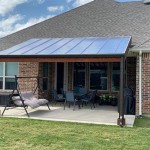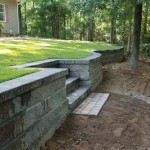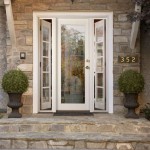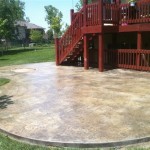How To Re-Level Patio Slabs: A Comprehensive Guide
Patio slabs, over time, can become uneven due to various factors such as soil erosion, settling, or improper initial installation. Uneven patio slabs pose a safety hazard, create an unsightly appearance, and can contribute to water pooling. Re-leveling patio slabs is a manageable DIY project, although it requires careful planning, preparation, and execution. This article provides a comprehensive guide to re-leveling patio slabs, outlining the necessary steps and considerations for achieving a flat and stable surface.
Assessing the Extent of the Problem and Determining Necessary Materials
Before embarking on the re-leveling process, it is crucial to conduct a thorough assessment of the patio's condition. This involves identifying all uneven slabs and determining the extent of the settling. A visual inspection is the first step. Look for visible dips, raised edges, or slabs that are clearly out of alignment with their neighbors. Use a level, either a spirit level or a laser level, to accurately measure the degree of unevenness. Note the height difference between the affected slab and the surrounding slabs. This measurement will be essential for determining the amount of leveling material required.
Next, investigate the potential causes of the settling. Check for signs of erosion around the edges of the patio or near downspouts. Look for evidence of root intrusion from nearby trees or shrubs. Address any underlying issues before re-leveling the slabs to prevent future problems. For instance, if erosion is a problem, consider installing drainage solutions or redirecting water flow away from the patio area. If root intrusion is suspected, consider root barriers or relocating plants.
Based on the assessment, gather the necessary materials. The primary material needed is leveling sand or paver base. Leveling sand is typically used for minor adjustments, while paver base, composed of crushed stone and binder, is better suited for larger adjustments and provides a more stable base. The choice between the two depends on the severity of the settling. Estimate the volume of leveling material required based on the height difference measured and the area of the affected slabs. It is advisable to purchase slightly more material than estimated to account for compaction and potential waste.
In addition to leveling material, other essential tools and materials include: a pry bar or screwdriver for lifting slabs, a rubber mallet for tapping slabs into place, a level (spirit or laser), a shovel or trowel for moving leveling material, a measuring tape, safety glasses, work gloves, and a broom or brush for cleaning. A wheelbarrow may also be helpful for transporting materials, especially for larger patio areas.
Preparing the Area and Lifting the Affected Slabs
Preparation is a critical step in ensuring a successful re-leveling project. Begin by clearing the patio area of all furniture, plants, and other obstacles. Sweep or brush the entire patio surface to remove debris and dirt. This will provide a clean working surface and improve visibility of the affected slabs. Before lifting any slabs, carefully examine the surrounding area to identify any potential hazards, such as buried utilities or weak points in the surrounding pavement. If buried utilities are suspected, contact the local utility company to mark the location of the lines before proceeding.
Lifting the affected slabs requires careful technique to avoid cracking or damaging them. Insert a pry bar or screwdriver into the gap between the affected slab and the adjacent slabs. Gently pry upwards, applying steady pressure to avoid sudden movements. If the gap is too narrow to insert a pry bar, use a flathead screwdriver to create a small opening. Once the slab is partially lifted, use your hands to carefully remove it from its position. If the slab is particularly heavy or difficult to lift, consider using a second person to assist. Place the lifted slabs on a protected surface, such as a piece of plywood or a tarp, to prevent scratching or damage.
With the slabs removed, expose the existing base material. Remove any loose or deteriorated material from the base. This may involve using a shovel or trowel to scrape away old sand, gravel, or dirt. Compact the existing base material using a hand tamper or plate compactor. Compaction is essential for creating a stable foundation for the re-leveled slabs. A stable base will prevent further settling and ensure the longevity of the repair. If the existing base is inadequate or severely deteriorated, consider removing it entirely and installing a new base layer of compacted gravel before adding the leveling material.
Adding Leveling Material and Setting the Slabs
After preparing the base, add the leveling material. The amount of leveling material required will depend on the depth of the depression and the chosen material (leveling sand or paver base). Use one or the other, do not mix them. For minor adjustments, a thin layer of leveling sand may be sufficient. For larger adjustments, a thicker layer of paver base will be necessary. Spread the leveling material evenly over the prepared base using a shovel or trowel. Use a level to ensure that the leveling material is flat and level with the surrounding slabs. A screed board can be helpful for creating a perfectly level surface. A screed board is a long, straight piece of wood or metal that is dragged across the leveling material to remove excess material and create a smooth, even surface.
Once the leveling material is in place, carefully set the lifted slabs back into their original positions. Ensure that the slabs are aligned with the surrounding slabs and that the joints between the slabs are consistent. Use a rubber mallet to gently tap the slabs into place, being careful not to crack or damage them. Regularly check the level of the slabs using a spirit level or laser level. Make adjustments as needed by adding or removing leveling material until the slabs are perfectly level. Pay close attention to the alignment of the slabs with the surrounding slabs. Any misalignment can create tripping hazards or detract from the overall appearance of the patio.
After all the slabs have been re-leveled, fill the joints between the slabs with jointing sand or polymeric sand. Jointing sand helps to prevent weeds from growing between the slabs and provides additional stability. Polymeric sand contains polymers that bind the sand particles together, creating a more durable and weed-resistant joint. Follow the manufacturer's instructions for applying jointing sand or polymeric sand. Typically, this involves sweeping the sand into the joints and then watering it to activate the binding agents. Be careful not to over-water the sand, as this can wash it away or cause it to stain the slabs. Allow the jointing sand or polymeric sand to dry completely before using the patio.
Finally, clean the entire patio area to remove any remaining debris or leveling material. Sweep or brush the patio surface to remove loose sand or dirt. Use a garden hose to gently rinse the patio, being careful not to disturb the jointing sand. Inspect the re-leveled slabs for any remaining imperfections. Make any necessary adjustments to ensure that the slabs are level and aligned. Allow the patio to dry completely before replacing furniture and other items.
Addressing Potential Problems and Long-Term Maintenance
Despite careful preparation and execution, certain problems may arise during the re-leveling process. One common issue is cracking or breaking slabs. This can occur if the slabs are old or fragile, or if they are subjected to excessive force during lifting or tapping. If a slab cracks, it may be necessary to replace it. Matching the existing slabs can be challenging, especially if they are old or discontinued. Consider contacting a local supplier of paving stones or concrete products to find a suitable replacement. If a perfect match is not possible, try to find a slab that is similar in color and texture to the existing slabs.
Another potential problem is ongoing settling. Even after re-leveling, slabs may continue to settle if the underlying soil is unstable or if there are ongoing drainage issues. Monitor the patio regularly for signs of settling. If settling occurs, repeat the re-leveling process as needed. In some cases, it may be necessary to address the underlying soil conditions to prevent further settling. This may involve excavating and replacing the soil with a more stable material, such as compacted gravel or crushed stone. Addressing drainage issues may involve installing subsurface drainage systems or redirecting water flow away from the patio area.
Regular maintenance is essential for preserving the level and appearance of the patio. Sweep or brush the patio regularly to remove debris and prevent weed growth. Clean the patio periodically with a mild detergent and water to remove dirt and stains. Inspect the joints between the slabs regularly and re-apply jointing sand or polymeric sand as needed. Seal the patio slabs with a concrete sealer to protect them from water damage and staining. Apply the sealer according to the manufacturer's instructions. Avoid using harsh chemicals or abrasive cleaners on the patio, as these can damage the slabs. By following these maintenance tips, the re-leveled patio slabs can remain level and aesthetically pleasing for years to come.

How To Repair Paving At B Q

How To Fix Uneven Patio Pavers

The Ultimate Guide To Perfectly Leveling Your Patio Diy Tips

How To Relay Loose Paving Slabs Sticking Down Rocking Pavers

How To Level A Patio With Slate Tile Easy Diy

How To Fix Uneven Concrete Slabs 5 Proven Options

How To Repair A Patio S Grouting Sinking Checkatrade

Julian Cas S Diy Blog Archive Replacing A Broken Slab How To What Use Where Buy

Low Cost Solution Laying Paving Slabs

How To Repair Paving At B Q
Related Posts








